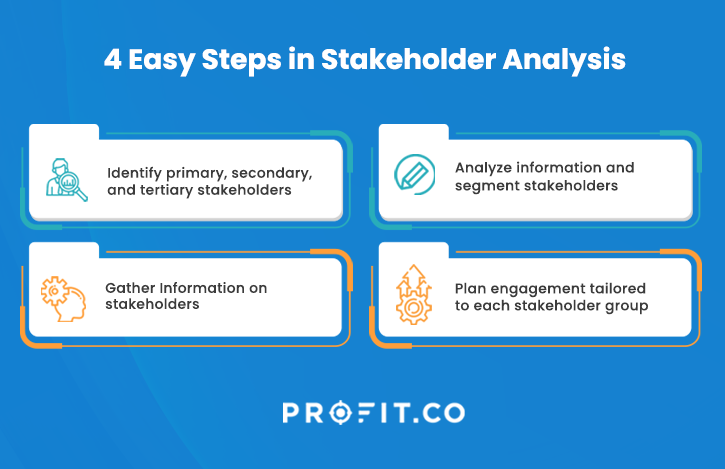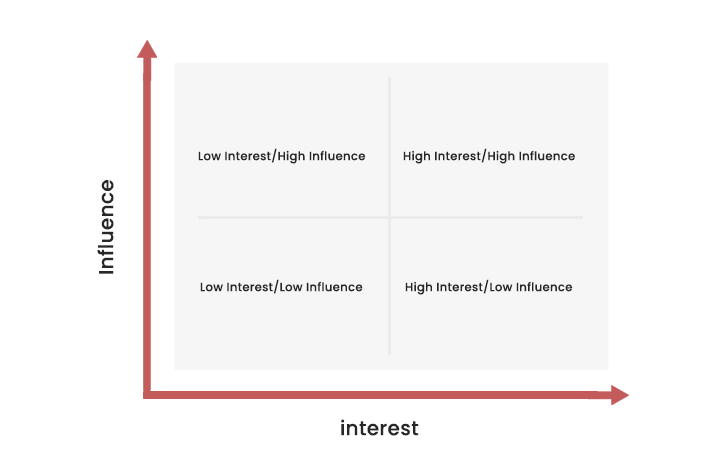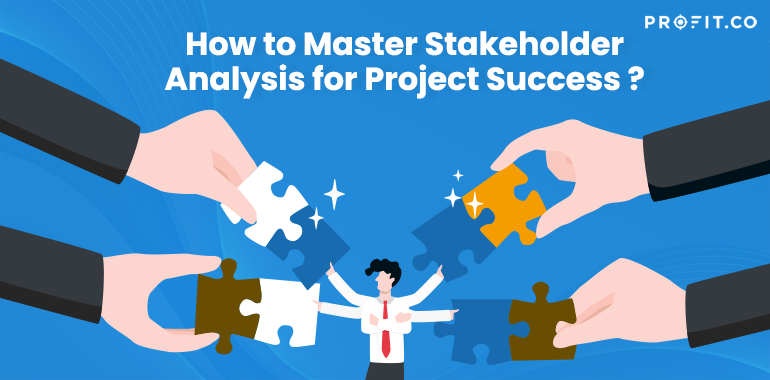Introduction
Picture yourself at the helm of an important project with high stakes. The atmosphere is charged, the team is driven, and you sprint towards the finish line. Then, out of nowhere, a stakeholder you have yet to learn about disrupts your plans. Their demands clash with the project’s fundamental objectives, and in no time, you find yourself entangled in a stakeholder drama that threatens to derail everything you’ve worked for.
Sound like a familiar nightmare? Well, it doesn’t have to be.
A critical part of project management is stakeholder analysis. This isn’t your typical, dull bureaucratic exercise – it’s an important step for stakeholder management for successful project outcomes.
What is a Stakeholder Analysis, and Why Should You Care?
Stakeholder analysis is a systematic approach used at the beginning of a project to identify all stakeholders, understand their needs and expectations, and strategize on how best to engage them throughout the project lifecycle. Stakeholders can range from investors and sponsors to team members and customers—anyone affected by the project’s outcomes.
Think of stakeholder analysis as a pre-project party where you meet everyone who might be impacted by your project, from the CEO who signs the checks to the intern making the coffee. You can avoid nasty surprises by understanding their interests, concerns, and level of influence.
Here’s why stakeholder analysis is important
- Identify probable conflicts early on so you can address them before they turn into full-blown stakeholder meltdowns.
- Tailor your communication to each stakeholder. No more bombarding the CEO with technical details or leaving key team members in the dark.
- When stakeholders feel heard and valued, they’re more likely to support your project.

How to Conduct a Stakeholder Analysis in 4 Easy Steps?
1. Identifying Stakeholders
Start by listing everyone with a stake in the project, including primary stakeholders (team members, clients) and secondary stakeholders (intermediaries). Remember tertiary stakeholders who may be less directly affected.
RACI, a common project management tool, helps establish a clear hierarchy of involvement for each task. This ensures everyone knows what’s expected of them.
Here’s the breakdown of RACI
- Responsible: The person who actually does the work.
- Accountable: The one who owns the final outcome and ensures it meets expectations.
- Consulted: Someone whose expertise is valuable during the process.
- Informed: kept in the loop on progress but was not directly involved.
However, RACI focuses on the initial loop and might miss external influencers – the observers. Though not initially considered stakeholders, these individuals or groups can still significantly impact project success. The takeaway? Don’t be surprised if those outside the initial list can derail your project. That’s why a comprehensive stakeholder analysis to Identify conflicts early is crucial, but proactively managing them is equally important.
Some strategies for resolving stakeholder conflicts include:
- Negotiation and compromise to find mutually acceptable solutions.
- Involving a neutral third-party mediator for complex conflicts.
- Escalating to higher authorities when conflicts cannot be resolved.
- Clearly defining decision-making processes and escalation paths.
“Great things in business are never done by one person. They’re done by a team of people.”
2. Gathering Information
Conduct interviews, surveys, and meetings to gather detailed information about the stakeholders’ needs, expectations, and the extent of their influence on the project. Brainstorm with everyone who might be affected by your project. Think internal (team members, executives) and external (clients, investors).
In addition to interviews, surveys, and meetings, consider these methods for comprehensive stakeholder data
- Focus groups for in-depth discussions with specific stakeholder segments.
- Observation of stakeholders in their actual work environments.
- Analysis of project documentation, reports, and communication trails.
- Social media monitoring for external stakeholder sentiments.
To learn more about achieving continuous learning for your organization
3. Analyzing Information
Use tools such as stakeholder maps and interest-influence matrix to visualize and prioritize stakeholder importance and influence. Rank your stakeholders based on their influence and importance. The CEO might have a strong influence, while the intern might have less. This helps understand who needs the most attention and how they should be engaged.
Benefits of stakeholder mapping
- Stakeholder mapping clarifies relationships and influence within the organization, improving communication and reducing misunderstandings.
- Formal analysis of stakeholder roles and power dynamics reveals critical influencers and relationships, aiding in more informed decision-making.
- Regular updates to the stakeholder map help organizations adapt to changes and maintain responsiveness in a dynamic environment.
The interest-influence matrix
The interest-influence matrix is a powerful tool in project management and stakeholder engagement. It helps visualize stakeholders’ relative involvement (interest) and power (influence) in a project or initiative. Plotting stakeholders on a 2×2 grid provides insights into how to best manage communication and engagement with each group.
Here’s a breakdown of the matrix:
- High Interest/High Influence:
These are your key players. They are strongly interested in the project’s outcome and have significant power to impact it. You must keep them closely informed, manage their expectations, and actively seek their input. - High Interest/Low Influence:
These stakeholders are enthusiastic but need more control. Inform them about progress and address any concerns they raise, but only need to involve them in some decisions. - Low Interest/High Influence:
These are the powerbrokers. Although they may not be directly involved in the project, they can significantly impact its success. Focus on understanding their needs and addressing any potential roadblocks they might create. - Low Interest/Low Influence:
These are the low-priority stakeholders. Monitor their sentiment occasionally, but dedicate only a little time to communication.

Benefits of using the interest-influence matrix
- Identify who needs the most attention and tailored communication strategies.
- Avoid bombarding stakeholders with information that’s not relevant to them.
- Handle issues before they arise by understanding stakeholders’ concerns.
- Foster collaboration and trust with key stakeholders.
By utilizing the interest-influence matrix, you can develop a targeted approach to stakeholder engagement, ultimately increasing your project’s success rate.
4. Planning Engagement
Develop a communication plan that targets each stakeholder group. Decide the mode, frequency, and intensity of communication required to keep stakeholders informed and involved. Not all stakeholders crave the same kind of communication.
Here’s a quick cheat sheet on stakeholder engagement
- Executives: High-level summaries, quarterly updates.
- Team Members: Regular team meetings, collaborative tools, and open communication channels.
- Clients: Project updates, milestone reports, and clear demonstrations of progress.
As projects often drive organizational changes, stakeholder analysis provides valuable inputs for change management strategies:
- Identify potential sources of resistance and plan mitigations.
- Prioritize engagement for stakeholders crucial for successful change adoption.
- Tailor communication and training plans based on stakeholder needs.
- Leverage influential stakeholders as change champions and advocates.
Stakeholders’ interests, influence, and priorities can change over the course of a project, so the analysis needs to be revisited and updated periodically.
Potential Challenges and Pitfalls
Be aware of these common challenges in stakeholder analysis and plan mitigations.
- Incomplete or inaccurate information about stakeholders.
- Cognitive biases impacting stakeholder assessments.
- Stakeholder reluctance to participate or share insights.
- Changing stakeholder dynamics over the project lifecycle.
- Resource constraints limiting the depth of analysis.
Conclusion
Stakeholder analysis is the key to navigating project complexities. By identifying all players, understanding their needs, and planning communication, you avoid surprises and build a winning team. Leverage tools like RACI, stakeholder maps, and the interest-influence matrix to prioritize engagement. Remember, stakeholder analysis is ongoing, so adapt your strategy as the project unfolds.
Ready to start your OKR Journey for FREE?
Related Articles
-
Mastering Resource Smoothing for Balanced Project Management
Effective project management requires more than just meeting deadlines. Today it demands balancing workloads to maintain not only team productivity... Read more
-
How to Use a Burndown Chart to Track Agile Project Progress
Project management is the art and science of planning, executing, and controlling projects to achieve specific goals and deliver customer... Read more
-
A Comprehensive Guide to Project Management Offices (PMO): Setup, Roles, and Benefits
A PMO centralizes and streamlines project management to enhance efficiency and performance while driving strategic business objectives. A Project Management... Read more
-
Understanding Lean Portfolio Management for Agile Success
Efficient portfolio management is vital for any modern business seeking to thrive. Market dynamics, customer needs and expectations, and technology... Read more

